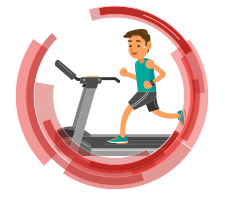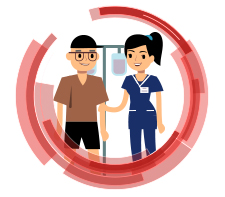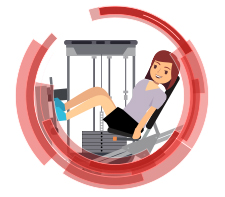Physiotherapy in Oncology Rehabilitation
Improvements in cancer diagnosis and treatment have led to an increase in number of people surviving and living longer. A new strategy to fight cancer is to focus on restoring health and quality of life. Despite improved survival, patients still need to face various problems from the disease itself and the side effects of the treatments. These include cancer-related fatigue, muscle loss, lymphedema, radiation-induced fibrosis, etc. Some of these problems may last for years. It hinders patients from resuming their normal daily routine. It also affects some patients’ ability to return to work. Our physiotherapists can provide an integrated and individualised rehabilitation programme to identify, address and mitigate these difficulties throughout the recovery journey.
Introduction of Oncology Rehabilitation
1. What is Oncology Rehabilitation?
Oncology rehabilitation is divided into 3 stages:
2. What are the problems patients would anticipate during the battle of cancer?
Cancer treatments can cause a variety of side effects. Some common problems are listed as follows:
| Cancer Treatment | Physical and Behaviour Complications |
| 1.Surgery 2.Radiation Therapy 3.Chemotherapy 4.Immunotherapy 5.Hormone therapy 6.Steroid | 1.Quality of life 2.Cardiovascular fitness 3.Physical function 4.Sarcopenia and increased risk of falls 5.Osteoporosis (increased risk of fracture) 6.Numbness 7.Lymphedema 8.Scar 9.Pain 10.Incontinence |
3. What is Oncology Rehabilitation?
| Period | Objectives |
| Prehabilitation | |
| •It is the time after cancer diagnosis and before any acute treatment. It is applicable to any treatment option including surgery, radiotherapy and chemotherapy. | It is a preparation period. Physiotherapists will examine patients’ baseline fitness level, provide education, and enhance their physical fitness and psychological well-being for consequences of the disease and the side effects of the treatment. Exercise intensity will usually be set at moderate level. |
| Rehabilitation | |
| •It is the time during active cancer treatment. •It usually lasts from1 to 6 months. | The aim of this stage is to enable patients to maximise their functional ability, minimise and treat any side effects, such as fatigue, pain and lymphedema. Exercise intensity is usually lower at this stage. |
| Survivorship | |
| •It is the life after active cancer treatment. It is for people with a stable disease or being disease-free. | •Monitoring and management of short-term and late effects of cancer and treatment are the focus. •Exercise training will target at optimising patients’ physical fitness. •The programme will help prepare patients to return to society and work. |

4. Content of oncology rehabilitation:
| Physical Problems | Corresponding Physiotherapy Services |
| •Cancer-related fatigue •Cardiomyopathy | Aerobic training improves cardiopulmonary function |
| •Sarcopenia •Osteoporosis | i.Strength training ii.Weight-bearing exercises |
| Balance problems | i.Balance training ii.Fall prevention programme |
| Lymphedema | i.Manual lymphatic drainage ii.Pressure garments and bandaging iii.Day-to-day care (e.g. when travel on the plane) |
| Scar | i.Manual therapy ii.Scar management device |
| Numbness | Joint mobilisation stretching exercises |
| Pain | Pain modality device e.g. Transcutaneous Electrical Nerve Stimulation (TENS) |
| Functional decline | Functional training |




